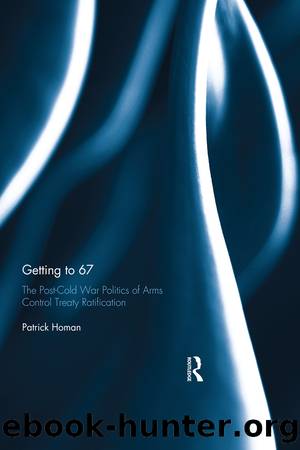Getting to 67: The Post-Cold War Politics of Arms Control Treaty Ratification by Patrick Homan

Author:Patrick Homan [Homan, Patrick]
Language: eng
Format: epub
Tags: International Relations, Treaties, Arms Control, Political Science, Political Process, General
ISBN: 9781317337553
Google: SKZACwAAQBAJ
Goodreads: 28410036
Publisher: Routledge
Published: 2015-12-22T00:00:00+00:00
Efforts of the Executive Branch
The Clinton administrationâs ratification strategy for advancing the CTBT proved to be largely inadequate in comparison to the overwhelming Republican opposition. In fact, the White House did very little while the CTBT was under consideration in the Senate for nearly two years. Democrats would point out that the defense played by Senate Republicans, such as Senator Jesse Helmsâ (R-NC) unwillingness to call hearings in the SFRC, was a major obstacle that kept them from effectively pushing for the treaty. Nevertheless, the ratification effort was never a top priority as the president and his staff focused on and allowed themselves to be distracted by other foreign policy crises and the fallout of the Lewinsky scandal. By the time the White House shifted into gear to promote the treaty, it was already too late. As one pro-treaty advocate stated, âThey just completely dropped the ball. You canât say itâs a top priority for foreign policy and then do nothing with it for two years.â25
President Clinton urged the Senate to ratify the CTBT in both his 1998 and 1999 State of the Union addresses. Yet, he lost 1998 due to the Lewinsky scandal and much of the first half of 1999 to the conflict in Kosovo. When President Clinton finally declared on October 2 that he would conduct an all-out effort for the CTBT, it was largely in response to the fact that Senate leaders had agreed to begin debate. President Clinton, the National Security Council staff, the White House legislative office, and the State and Defense Departments shifted into high gear to promote the treaty. However, aides close to the president acknowledged that he made little effort to build support until Republicans caught them off guard by putting the CTBT on the agenda for a speedy vote.26
The time limitations that the unanimous consent agreement placed on the process provided little opportunity for the White House to wield its enormous influence over the debate and eventual vote. With the vote scheduled to take place on October 12 or soon thereafter, President Clinton had less than two weeks to exercise his formidable public relations skills to try and persuade senators and gather support for the CTBT. As David Leavy, a spokesman for the National Security Council, said, âThe President is fully committed to the treaty. We [just] hope there can be adequate time for debate and analysis.â27 In a sense, the Clinton administration, by inattention or ineptitude, allowed itself to be out-maneuvered into a compressed timetable that left little time for an intensive lobbying campaign.
Even with such a short time frame to work with, President Clinton did assume a large role in launching an intense campaign to persuade reluctant Senate Republicans to vote for the CTBT. On October 5, Clinton hosted a small dinner at the White House with undecided senators. The following day he held a rally in the White House Rose Garden with a broad array of treaty backers. President Clinton also appealed to undecided senators in one-on-one and small group meetings, and made his case for the CTBT before the news media.
Download
This site does not store any files on its server. We only index and link to content provided by other sites. Please contact the content providers to delete copyright contents if any and email us, we'll remove relevant links or contents immediately.
Spell It Out by David Crystal(35852)
Life for Me Ain't Been No Crystal Stair by Susan Sheehan(35539)
Cecilia; Or, Memoirs of an Heiress — Volume 1 by Fanny Burney(32067)
Cecilia; Or, Memoirs of an Heiress — Volume 3 by Fanny Burney(31463)
Cecilia; Or, Memoirs of an Heiress — Volume 2 by Fanny Burney(31412)
The Great Music City by Andrea Baker(30785)
Professional Troublemaker by Luvvie Ajayi Jones(29425)
We're Going to Need More Wine by Gabrielle Union(18640)
Twilight of the Idols With the Antichrist and Ecce Homo by Friedrich Nietzsche(18303)
The Secret History by Donna Tartt(18186)
Cat's cradle by Kurt Vonnegut(14768)
All the Missing Girls by Megan Miranda(14765)
Pimp by Iceberg Slim(13787)
Bombshells: Glamour Girls of a Lifetime by Sullivan Steve(13691)
Fifty Shades Freed by E L James(12923)
Talking to Strangers by Malcolm Gladwell(12887)
Norse Mythology by Gaiman Neil(12846)
The Social Justice Warrior Handbook by Lisa De Pasquale(11957)
Underground: A Human History of the Worlds Beneath Our Feet by Will Hunt(11841)
